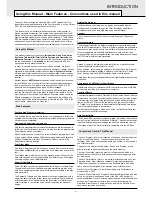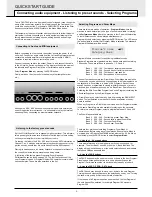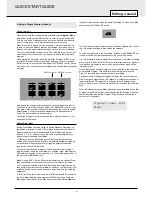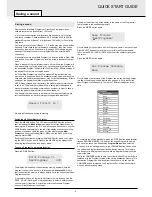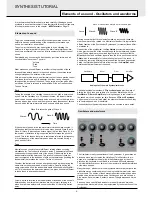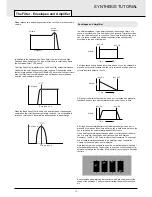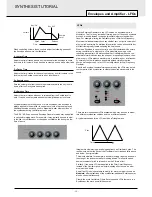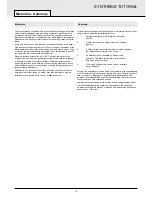
•
2
•
Thank you for purchasing the Novation KS4 or KS5 Synthesizer. This
instruction manual applies equally to the Four Octave KS4, or Five Octave
KS5 - the only difference being the number of keys.
This instrument is a multi-timbral, enhanced version of the popular K-
Station keyboard synthesizer. The design of the has evolved from the K-
Station, using the very latest award-winning Novation technology found in
highly-acclaimed products such as Nova and Supernova II. The KS4 and
KS5 are capable of producing an enormous range of high quality synthe-
sized sounds and are ideal machines for a home studio set-up or for an
experienced producer looking to add an extra dimension of sound power.
Using this Manual
This manual consists of six sections,
Introduction, Quick Start Guide,
Synthesis Tutorial, MIDI Tutorial, Main Features and Operation,
and
Advanced Features
. For easy reference, the section name is printed at
the top of each page. An
Appendix
on the final pages lists all menu
options and factory preset sounds list.
In order to become an expert user as quickly as possible, it is recom-
mended that this manual is read in sequence chapter by chapter. If sound
synthesis is an unfamiliar subject, then the chapter
Synthesis Tutorial
will provide a useful introduction to the techniques used to electronically
simulate the sound of a musical instrument using an analogue music syn-
thesizer.
Another chapter,
MIDI Tutorial
provides an useful introduction to the sub-
ject of MIDI and how it is used for communication between instruments
and / or sequencers. The chapter also describes how the KS4 / KS5
transmits and recognizes various types of MIDI messages.
If the general principles of Sound Synthesis and MIDI are already familiar,
then the Quick Start Guide is the place to begin. Once familiar with the
main features of the machine, the Advanced Features section covers the
Effects, Arpeggiators, Synchronization, Triggering and the Utilities, and
will provide all of the information needed to operate the KS4 / KS5 in the
most creative, productive way. Have fun !
Main Features
Four hundred Program memories
Two hundred factory programmed sounds are included and a further two
hundred user sound memory locations are provided (factory programmed
sounds may be overwritten).
One hundred Performance memories
Fifty factory programmed multi-timbral Performances are included and a
further fifty user Performance locations are provided (factory programmed
Performances may be overwitten).
Each Performance can consist of up to four different Programs, each with
its own unique effects settings, MIDI channel assignments and keyboard
settings. Program data for each Performance Part are stored in the
Performance memory location.
Four Drum Maps
Two factory programmed Drum Maps are included with a further two user
Drum Maps available (factory programmed Drum Maps may be over-writ-
ten).
Drum Maps allow a whole drum kit to be mapped across 49 notes of the
keyboard with each drum sound available on a different key. Drum Maps
consume only one unit of Multi-timbrality.
Powerful Oscillators
Three Oscillators provide the standard Sawtooth, Square, Variable Pulse,
Triangle and Sine waves. Additional sampled waveforms are also avail-
able, each containing complex audio information not available in the stan-
dard waveforms.
The Sawtooth, Triangle and Sine waveforms may be duplicated within a
single Oscillator to provide thicker sounding waveforms. Synchronization
and FM between two Oscillators allow the generation of metallic or per-
cussive timbres. A four section noise source completes the waveform
engine.
External Audio Input
The Mixer allows an external audio signal to be combined with the
Oscillators and processed through the Filter, Envelopes and Effects.
Envelopes may also be auto-triggered by an external signal.
Vocoder
The 16 band Vocoder makes it easy to create Robot and Talky sound
effects.
Four Arpeggiators
The arpeggiator features six different operational modes with adjustable
gate time for staccato effects. Thirty two rhythmic patterns are available to
introduce complex motion effects. In multi-timbral Performance Mode, up
to four arpeggiators are available simultaneously, each with their own
unique settings. All four arpeggiators can can be individually synchronised
to MIDI Clock at different time signatures.
HyperSync
Sixteen ‘Hypersync’ templates provide fast,effective, musically synchro-
nized settings with a simple twist of a control.
When selected, synchronisation settings to four Effects and four Program
parameters are instantly applied. Settings for the Delay level, Chorus
Level, Panning Depth and EQ Modulation Depth are also applied.
Using these tempo synchronized features can significantly enhance music
production.
Comprehensive MIDI Control Specification
Adjustments of any controls transmit MIDI Controller numbers or NRPNs
for real time recording by a sequencer or computer.
Powerful Effects
The effects processor includes Distortion, Stereo Chorus, Phaser, Reverb,
Synchronized Delay and Synchronized Stereo Panning. Complex, dynam-
ic timbres may be created using tempo synchronized effects settings. A
final output EQ and Filter section complete with a tempo synchronized
LFO allow for a performance to be automatically filtered and time locked
from 32nd triplets through to several bars.
In multi-timbral Performance Mode, each of the four individual Parts can
have its own unique Effects settings.
Data Compatibility
The KS4 and KS5 have been designed to allow the loading of Sysex data
dumps from the Novation K-Station and A-Station. This ensures that exist-
ing sound libraries and global settings can easily be transferred from the
older types of machine. Data is also fully compatible with the KS Rack.
Conventions Used In This Manual
The word ‘Program’ refers to a collection of knob and switch settings that
define an individual ‘Sound’. These settings are then saved as a
‘Program’ which has a corresponding name and number in the machine’s
non volatile memory.
Throughout this manual the two words, ‘Sound’ and ‘Program’ are fre-
quently referred to and essentially have the same meaning.
The term ‘Drum Map’ refers to a whole kit of drum sounds which are
mapped across the keyboard, with each keyboard note triggering a differ-
ent drum sound.
The word ‘Performance’ refers to a multi-timbral setting where up to four
Programs and/or Drum Maps are available for playing simultaneously.
This entire arrangement is then saved as a ‘Performance’ which has a
name and number assigned in the machine’s non-volatile memory.
Each of the four Programs / Drum Maps making up a Performance is
referred to as a ‘Part’.
The word ‘Preset’ refers to a Program/Performance/Drum Map which was
set up at the factory to showcase some of the KS4 / KS5’s powerful
sound possibilities. Preset memories may actually be overwritten with new
settings, but it is possible to restore them to the original factory set
Programs, Drum Maps or Performances by loading in a MIDI file if they
have been overwritten by mistake.
INTRODUCTION
Using this Manual - Main Features - Conventions used in this manual


